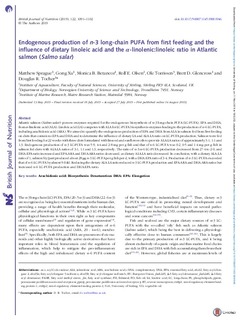Endogenous production of n-3 long-chain PUFA from first feeding and the influence of dietary linoleic acid and the α-linolenic:linoleic ratio in Atlantic salmon (Salmo salar)
Sprague, Matthew; Xu, Gong; Betancor, Monica B; Olsen, Rolf Erik; Torrissen, Ole; Glencross, Brett D.; Tocher, Douglas R.
Journal article, Peer reviewed
Published version
Permanent lenke
http://hdl.handle.net/11250/2636542Utgivelsesdato
2019Metadata
Vis full innførselSamlinger
- Articles [3016]
- Publikasjoner fra CRIStin [3074]
Sammendrag
Atlantic salmon (Salmo salar) possess enzymes required for the endogenous biosynthesis of n-3 long-chain PUFA (LC-PUFA), EPA and DHA, from α-linolenic acid (ALA). Linoleic acid (LA) competes with ALA for LC-PUFA biosynthesis enzymes leading to the production of n-6 LC-PUFA, including arachidonic acid (ARA). We aimed to quantify the endogenous production of EPA and DHA from ALA in salmon fed from first feeding on diets that contain no EPA and DHA and to determine the influence of dietary LA and ALA:LA ratio on LC-PUFA production. Salmon were fed from first feeding for 22 weeks with three diets formulated with linseed and sunflower oils to provide ALA:LA ratios of approximately 3:1, 1:1 and 1:3. Endogenous production of n-3 LC-PUFA was 5·9, 4·4 and 2·8 mg per g fish and that of n-6 LC-PUFA was 0·2, 0·5 and 1·4 mg per g fish in salmon fed diets with ALA:LA ratios of 3:1, 1:1 and 1:3, respectively. The ratio of n-3:n-6 LC-PUFA production decreased from 27·4 to 2·0, and DHA:EPA ratio increased and EPA:ARA and DHA:ARA ratios decreased, as dietary ALA:LA ratio decreased. In conclusion, with a dietary ALA:LA ratio of 1, salmon fry/parr produced about 28 μg n-3 LC-PUFA per g fish per d, with a DHA:EPA ratio of 3·4. Production of n-3 LC-PUFA exceeded that of n-6 LC-PUFA by almost 9-fold. Reducing the dietary ALA:LA ratio reduced n-3 LC-PUFA production and EPA:ARA and DHA:ARA ratios but increased n-6 LC-PUFA production and DHA:EPA ratio.
